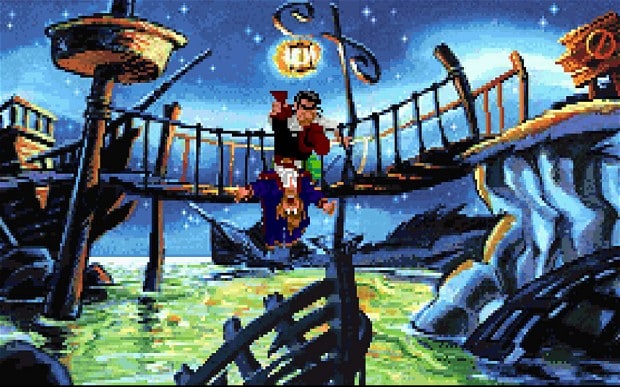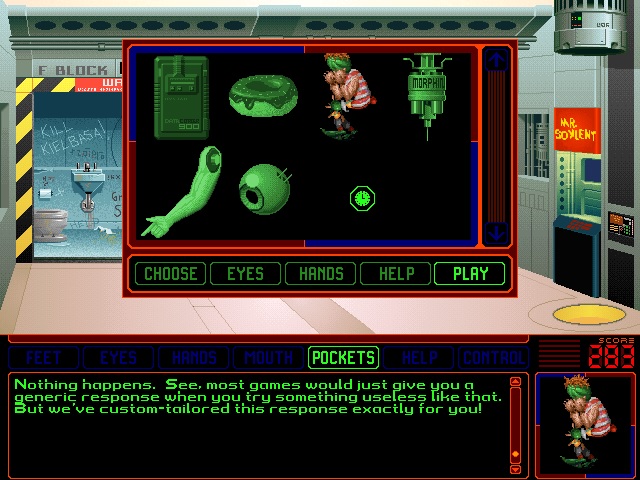The role of self- conscious humor in adventure gamedesign
Krista Bonello Rutter Giappone’s article on point and click adventure games analyzes the genre’s tendency towards parody on three different levels (intertextual allusion, metafictional self-reflexivity, and meta-mediality) by analyzing three games in particular: Zork, the Monkey Island series and Sam and Max. These three games represent different eras of adventure game design: primordial text based adventures (Zork), the graphic adventures of 90s which represent the genre’s heyday (Secret of Monkey Island) and nostalgic callbacks that simultaneously parody and fondly reminisce aforementioned golden age of graphical adventures (Telltale’s Sam and Max games).
The article uses Guillén’s definition of parody as a countergenre: the idea that when a genre becomes established, a parody which lampoons its central characteristics is its “countergenre”. Since parody dwells in its target, it forms a symbiotic relationship with it, which is the “central paradox of parody”. This self-referentiality is an essential part of the metafictional humor that characterizes the genre. Metafictionality refers to intentionally signaling to the player that the game they’re playing is fiction. One example of that is a joke where the player character breaks the “fourth wall” by addressing the player directly for humorous purposes. Self-referential metafiction could in this case refer to the game character pointing out an adventure game trope within the game.

The text based adventure Zork (1977) was a seminal title for the foundation of the genre. The text parser played a key role in the game’s comic nature, as the developers saw the exploration of “useless actions” as a chance to add in a lot of humor value to the game: there are various clever and unexpected responses to otherwise useless actions, and the designers anticipated that players would test the limits of the parser by adding responses to words such as “fuck” and “shit”.
Lebling comments that the designers seemingly intended for the game’s “narrator” to seem simultaneously omniscient and personable, so that it would resemble a Dungeons and Dragons dungeon master. That Dungeons and Dragons influence was also felt in the games labyrinthine level design. The game featured mazes and dead ends, which are a “feature” that games released after Secret of Monkey Island started intentionally getting rid of.
Secret of Monkey Island (1990) is noted for its move towards less punishing adventure game design. Whereas Zork and earlier Sierra developed titles such as King’s Quest (1984) and Space Quest (1986) featured dead ends and punished the player for “wrong” choices via (often unexpectable) character-death, the player could not die or get permanently stuck in Monkey Island and other adventure games developed by LucasArts.
Without the fear of a game over screen constantly looming in the players’ horizon, this granted players more freedom to explore different options of the game, and subsequently gave the developers a chance to cram in more comedic responses to the different actions the player could perform.
Conversely, the developers could also derive humor from drawing attention to the limitations imposed upon the player by the game.For example, Monkey Island’s main character Guybrush Threepwood might decline to pick up a useful object due to a personal whim or aversion (“Ugh! Porcelain!).
“I feel my agency being denied”, Sam comments in Sam and Max: Reality 2.0 when the game refuses the player to take an action which would force him/her to re-do much of the game. Despite its more lethal nature, earlier Zork also showcased a similar whimsical nature by refusing the player from performing certain actions which should be logical.
“Z: A dark chimney leads down. >d. Z: Only Santa Claus climbs down chimneys.”
Those examples are microcosms of the authors’ view on the pervasive role that intertextual allusion and metafictional self-reflexivity play in the humor and design of adventure games and their puzzles. She states that her aim was to identify certain tendencies of the genre, which she accomplished by mostly focusing on a few important titles rather than attempting to make a thorough reading of the genre, which isn’t homogenous. Yet, she posits that metafictional humor has become an intrinsic part of the genre, as adventure games self-consciously draw attention to the conventions they use as a basis for humor. Fernández-Vara, whom she quoted, identified that the pattern for adventure game puzzles is to “magnify a trivial action into a puzzle”. As players’ familiarity with this convention is under the parodic gaze of many adventure games, the genres’ conventions and mechanical tropes become inseparable from their parody.
Original article: http://gamestudies.org/1501/articles/bonello_k


